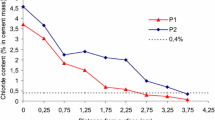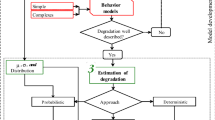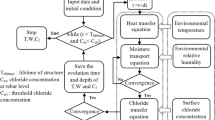Abstract
The durability and service life of reinforced concrete structures in the marine environment have been the subject of several studies in the literature, due to the great importance for port infrastructure and the high level of aggressiveness offered by this environment to reinforced concrete structures, mainly by the chloride ions action in the corrosion of the reinforcement. In this way, the present chapter deals with the modeling of chlorides concentration profiles, where an analysis recently developed for application of the Modified Holliday Equation is presented. For this, different profiles models were performed, representing different materials and environmental conditions using this new methodology. The results showed that the model based on the Modified Holliday Equation can represent the diffusion zone for structures with different characteristics (materials, environmental, age and location), and is also able to represent chloride concentrations in the convection zone, allowing to estimate the service life of structures built in marine environments around the world.
Access this chapter
Tax calculation will be finalised at checkout
Purchases are for personal use only
Similar content being viewed by others
References
American Society for Testing and Materials (2012) ASTM C1152: 2012: standard test method for acid-soluble chloride in mortar and concrete. West Conshohocken
Apostolopoulos CA (2009) The influence of corrosion and cross-section diameter on the mechanical properties of B500c steel. J f Mater Eng Perform 18(2):190–195
Apostolopoulos CA, Demis S, Papadakis VG (2013) Chloride-induced corrosion of steel reinforcement: mechanical performance and pit depth analysis. Constr Build Mater 38:139–146
Balestra CET et al (2016) Corrosion degree effect on nominal and effective strengths of reinforcement naturally corroded. J Mater Civil Eng 28(10):04016103
Balestra CET, Lima MG, Mendes AZ, Medeiros-Junior RA (2018) Effect of corrosion degree on mechanical properties of reinforcements buried for 60 years. IBRACON Struct Mater J 11(3):474–498
Balestra CET, Nakano AY, Savaris G, Medeiros-Junior RA (2019a) Reinforcement corrosion risk of marine concrete structures evaluated through electrical resistivity: proposal of parameters based on field structures. Ocean Eng 187:106167
Balestra CET, Reichert TA, Pansera WA, Savaris G (2019b) Chloride profile modeling contemplating the convection zone based on concrete structures present for more than 40 years in different marine aggressive zones. Constr Building Mater 198:345–358
Balestra CET, Reichert TA, Savaris G (2019c) Contribution for durability studies based on chloride profiles analysis of real marine structures in different marine aggressive zones. Constr Building Mater 206:140–150
Balestra CET, Savaris G, Nascimento RS, Medeiros Jr RA (2019d) Relations between chloride determination in real concrete structures by X-ray Fluorescence spectroscopy and by potentiometric titration. J Build Pathol Rehab 4(18)
Balestra CET, Reichert TA, Pansera WA, Savaris G (2020) Evaluation of chloride ion penetration through concrete surface electrical resistivity of field naturally degraded structures present in marine environment. Constr Building Mater 230:1169789
Broomfield JP (2007) Corrosion of steel in concrete: understanding, investigation and repair. Taylor & Francis, London, p 294
Castro P, De Rincon OT, Pazini EJ (2001) Interpretation of chloride profile from concrete exposed to tropical marine environments. Cement Concrete Res 31:529–537
François R, Khan I, Dang VH (2013) Impact of corrosion on mechanical properties of steel embedded in 27-year-old corroded reinforced concrete beams. Materi Struct 46(6):889–910
Mehta PK, Monteiro PJM (2006) Concrete: microstructure, properties and materials. 3th edition. Mc-Graw Hill. New York, 674 p
Neville AM, Brooks JJ (2010) Concrete technology. 2st Ed. Pearson. London. 448 p
Nunes JLO, Guimarães ATC (2006) Seawater distance- Factor to be considered in the chloride attack intensity. II Ocean Engineering Workshop Federal University of Rio Grande, 2006. Available in: http://repositorio.furg.br/handle/1/1644?fbclid=IwAR3s6cYJ2pkdy-SgwVwiEN_13b9iVSy5hFnmcqvH7CqKC33i1zRVgtWsC1k (In Portuguese)
Pang L, Li Q (2016) Service Life prediction of RC structures in marine environment using long term chloride ingress data: comparison between exposure trials and real structures surveys. Constr Building Mater 113:979–987
Tang L (2003) Chloride ingress in concrete exposed to marine environment—Field data up to 10 years exposure. Swedish National Testing and Research Institute. Building Technology and Mechanics. SP REPORT 2003:16. 68 p. Available in: http://www.diva-portal.org/smash/get/diva2:962253/FULLTEXT01.pdf?fbclid=IwAR3Jx1g8JNEkpCexF6El0q8bM380MfDVDZDGy-j_rSf2EoFCDYdTtexPgRM
Vieira DR, Moreira ALR, Calmon WK, Dominicini WK (2018) Service life modeling of a bridge in a tropical marine environment for durable design. Constr Building Mater 163:315–325
Wang Y, Wu L, Wang Y, Li Q, **ao Z (2018) Prediction model of long-term chloride diffusion into plain concrete considering the effect of heterogeneity of materials exposed to marine tidal zone. Constr Building Mate 1593:297–315
Author information
Authors and Affiliations
Corresponding author
Editor information
Editors and Affiliations
Rights and permissions
Copyright information
© 2021 The Author(s), under exclusive license to Springer Nature Switzerland AG
About this chapter
Cite this chapter
Balestra, C.E.T., Reichert, T.A., Vizzotto, A.L.P., Savaris, G. (2021). Chloride Profile Modeling for Reinforced Concrete Structures Present in Marine Environment. In: Delgado, J.M.P.Q. (eds) Durability of Concrete Structures. Building Pathology and Rehabilitation, vol 16. Springer, Cham. https://doi.org/10.1007/978-3-030-62825-3_3
Download citation
DOI: https://doi.org/10.1007/978-3-030-62825-3_3
Published:
Publisher Name: Springer, Cham
Print ISBN: 978-3-030-62824-6
Online ISBN: 978-3-030-62825-3
eBook Packages: EngineeringEngineering (R0)




